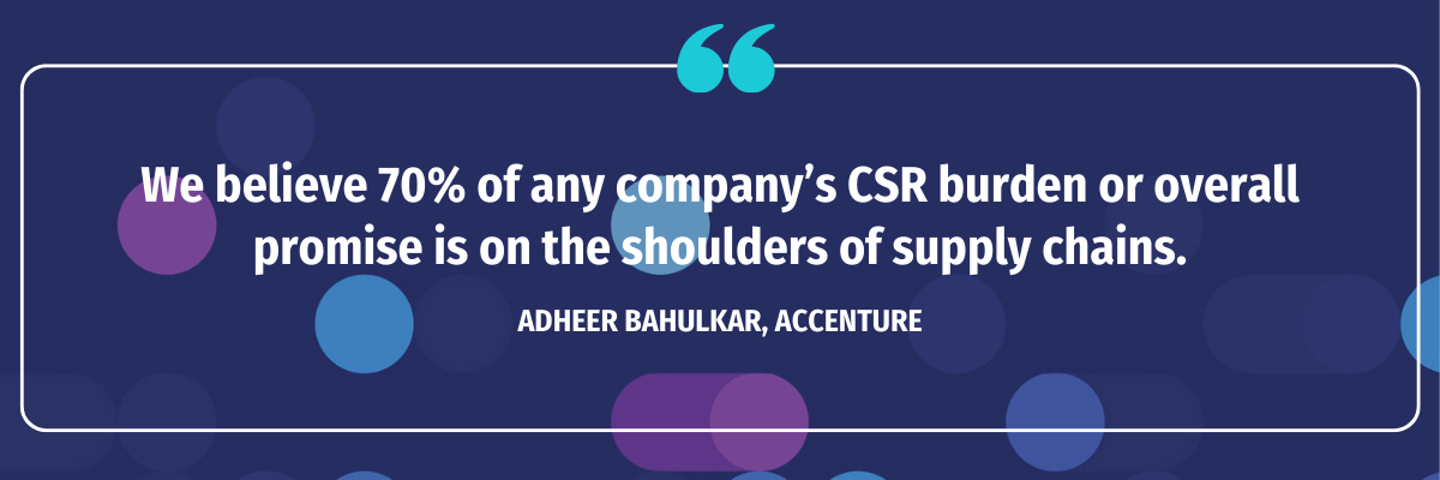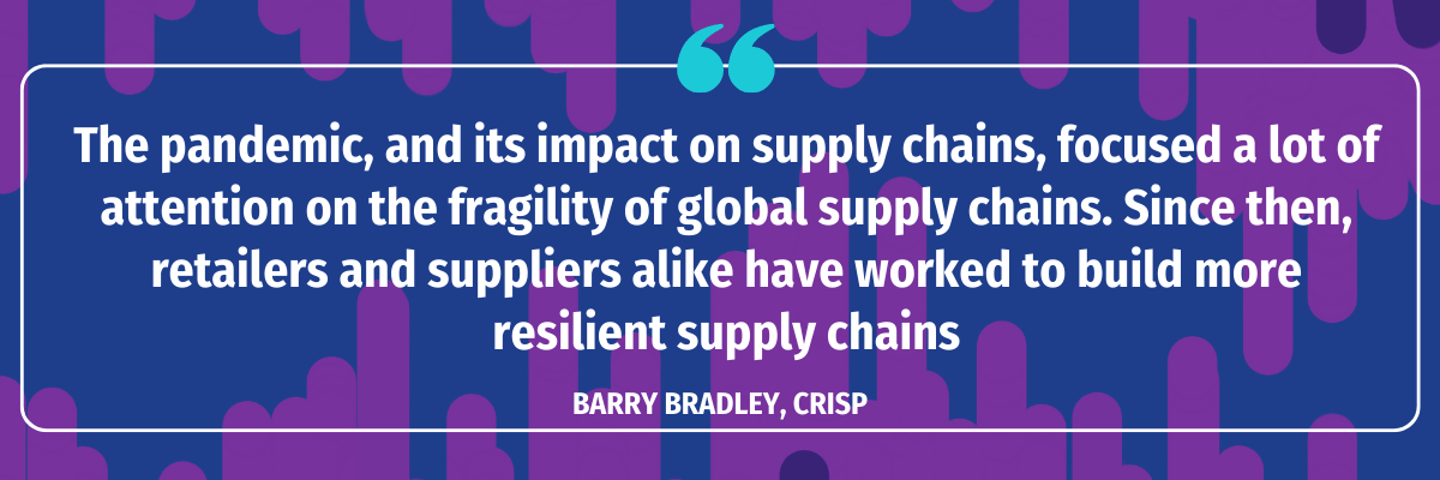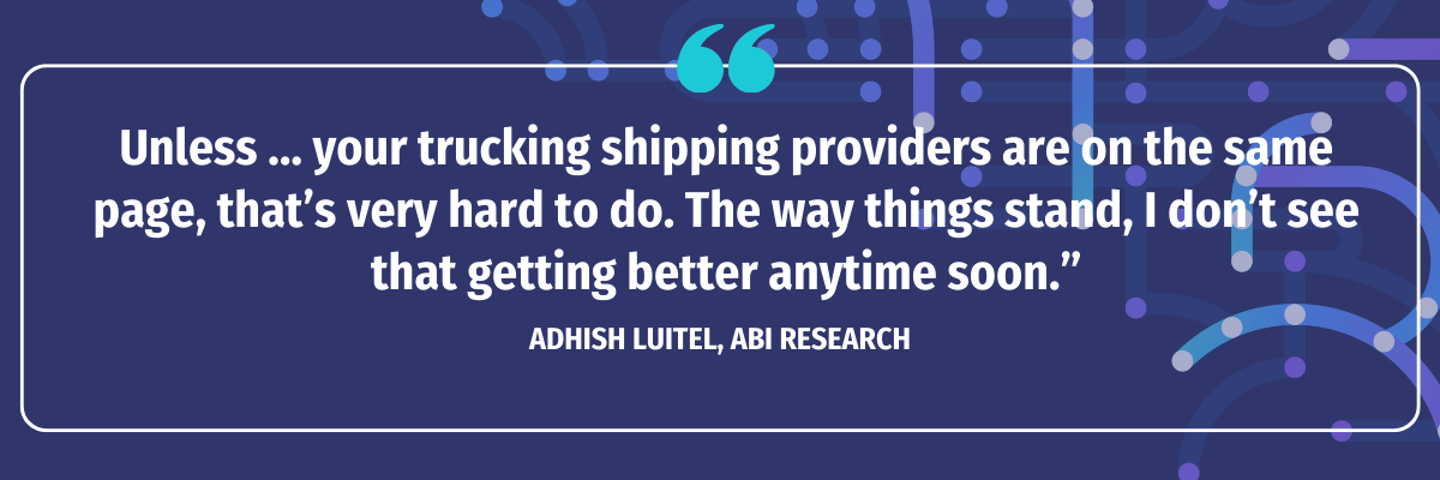Supply Chain Technology Trends
If you thought 2023 would be the year to breathe a sigh of relief that supply chain woes were dissipating, think again. Even with the pandemic squarely in the rearview mirror, supply chain operations remain somewhat volatile in the CPG industry, thanks to inflation, fluctuating consumer demand, labor shortages, geopolitical issues, continued logistics woes, and extreme weather.
These variables are prompting increased investment in supply chain technology. “Supply chain and operational capabilities will be front and center in 2023,’’ according to KPMG. “Importantly, there will likely be greater investment to uplift supply chain planning maturity, automation of warehouse and operational tasks, as well as in gathering better end-to-end supply chain analytics to create enhanced visibility.”
Two supply chain predictions from ABI Research echo that: “Mounting regulations will push the supply chain and logistics industry to invest in and adopt end-to-end visibility and reporting capabilities,’’ the firm said, adding that adoption of supply chain visibility platforms will continue to enable companies to ensure both compliance and operational competitiveness.
Visibility may help assuage stakeholder wariness. A Deloitte survey on customer trust in supply chains found that close to half (44%) of all supply chain executives expect to experience a supply chain shock in the next 24 months as a result of various external challenges including price volatility (46%), inflation (44%), resource shortages (e.g., labor and materials, 42% and 41% respectively), and geopolitical instability (32%).
What are the 6 main components in supply chain management?
To understand the current state of the supply chain and key supply chain trends at top CPG companies, it’s important to know the different components, which vary, depending upon whom you ask. They include product design, planning, procurement, manufacturing, distribution, and selling, according to Adheer Bahulkar, managing director and global supply chain leader for consumer goods at Accenture.
These components are tied with source-to-pay and order-to-cash at the front end—meaning how to take orders and accept payment, and then forecasting to fulfill them, which is about planning for demand and optimizing along the way, he says.
Planning involves developing an overall strategy including sourcing and selecting providers, says Adhish Luitel, a senior analyst in ABI Research’s supply chain management and logistics division. Then there is logistics/transportation, distribution, and integration, which includes communicating and collaborating with all stakeholders.
Manufacturing, purchasing, and operations — including supply, product, demand, field and sales planning, and managing suppliers — are other components, Luitel says.
“I think of the three main components of supply chain management as making, moving, and selling goods,’’ observes Joel Beal, CEO and co-founder of Alloy.ai, a provider of demand and inventory control towers.
“Some people may not include the selling of goods in supply chain management, but I absolutely believe it is’’ a key component, Beal adds. “Most people would say demand planning is a part of supply chain management, and the whole point of it is to sell goods. To me, the sale is a pretty critical part.”
Barry Bradley, head of supply chain at Crisp, a commerce platform for consumer goods companies, boils it down to four basic components:
Right product: Offer the product that is in demand. This requires visibility into demand signals to know what product consumers want and, therefore, what (and how much) you should produce.
Right place: Get the product consumers want to the place they can get it. Suppliers need data across all retail locations to see what the trends are (right product) and where those trends are happening, such as which retailer, region, store format, etc. This informs product assortments and inventory allocation.
Right time: Get the right product to the right place when needed. You can have a great product that’s in demand and know where to send it, but if you can’t get it there at the right moment, you can’t sell it. Real-time data is required to see and react to trends faster, so you can deliver to retailers on time and in full.
Right cost: Do all of the above at a cost that keeps your company profitable. For example, if you’re a low-margin food company and sales are spiking in New York, but your facilities are in California, flying that product to New York will quickly run you out of business.
“Visibility into where demand really is enables suppliers to make better decisions about how they move [the] product, Bradley says, “so they can plan further ahead and therefore, have more time to get the product where it needs to go in a cost-effective manner.”
What are the trends shaping the global supply chain in 2023?
In terms of trends in supply chain management, executives who portrayed their organizations as "leading suppliers" were 3.9 times more likely to have a fully deployed digital thread (27% versus 7% for non-leading suppliers) and 3.8 times more likely to use predictive analytics to forecast demand (38% versus 10% for non-leading suppliers), according to the KPMG survey of more than 1,000 executives from large global organizations.
Perhaps the most significant trend impacting supply chains in 2023 is “we’re starting to see them “struggling and being challenged less from the supply side and more from the demand side,’’ observes Bahulkar.
Earlier this year, the commodity markets situation began improving, he says, so raw materials and global transportation challenges have eased off — not necessarily because of more supply — but rather, a combination of companies building more resiliency, identifying alternative sources, and creating alternate manufacturing where it made sense, Bahulkar says.
At the same time, however, inflationary concerns are decreasing consumer demand for consumer products. “On average, 66% of consumers are concerned about the economy over the next six months, and that’s directly impacting discretionary purposes,’’ he says. “Supply chain challenges are manifested in the sense that we now have a lot of volatility and predictability on the demand side, and the big question becomes, how much do we produce?”
So CPG brands must rethink their production planning, Bahulkar says.
Paul Silverglate, vice chair of Deloitte and U.S. technology sector leader, says that key global supply chains trends in 2023 include:
Automation: Consumer goods companies are adopting robotic process automation (RPA), Generative AI, intelligent automation, and hyper-automation to improve efficiency and extend the life of legacy systems.
Sustainability: Companies' efforts to consider the environmental and human impact of their products' journeys through the supply chain, from raw materials sourcing to production, storage, delivery, and every transportation link in between.
Digitization: The evolution towards a smarter model that involves digital technologies such as blockchain, IoT, machine learning, etc. These technologies actually increase and enhance the ability to optimize planning, sourcing, and procurement strategies.
Supplier and Customer Collaboration: How to ensure cost competitiveness in the future while de-risking your cost-optimized supply and customer base(s).
Innovation: Looking at the way a company applies its assets, operating resources, and capabilities to develop new ways to satisfy customer needs. A CPG company should measure the value of innovations by how well they help meet customer demands.
Flexibility: The ability to easily adjust production levels, raw-material purchases, and transport capacity.
Agility: The diversification of sourcing and assembly locations to build more agile supply chains.
Trade/Geopolitical tension (China +1): Ensuring supply stability/source diversification.
What are the main supply chain challenges today?
The issue of visibility also factors into one of the biggest supply chain challenges, which is inaccuracies in inventory counts, says Luitel. “For example, if you’re looking to get something from Walmart, like a gallon of milk, you may see online that there are 15 bottles in stock, but when you go to collect it, it’s already out of stock. So there’s no item-level visibility … that’s one of the biggest challenges we’re seeing from the retail perspective.”
Another is the ability for retailers to offer shorter delivery times, or what Luitel refers to as the “Amazon effect.” A lot of retailers aren’t able to do what Amazon can because they don’t have as many warehouses and trucks spread throughout the country, he says. The … trend to deliver the same day or in the next couple of days has caused a lot of problems for a lot of retailers.”
Bahulkar notes that consumers may grow tired of paying more for a certain product so brands face the risk of them going to competitors, a private label, or halting spending, especially if it is discretionary.
Beal concurs, saying that costs and pricing pressure are the biggest challenges right now. “Companies can no longer pass on cost increases to customers, who have grown weary of price hikes,’’ he says. “For a few years, a lot of growth was achieved not through increased sales volume but by selling products at elevated prices. Today consumers and retailers are both pushing back.”
Another challenge is global economic uncertainty, especially for global CPG companies around the unknown, the potential for more disruptions, and how much resiliency and redundancy they need to build, as well as how many more manufacturing alternatives they need. So that is creating a lot of growth opportunities, “but we don’t want to repeat the same mistakes we learned from the pandemic year,” Bahulkar says.
This continues to surface as a top agenda item for organizations, he adds.
Beal says a lot of the businesses that initially — and perhaps unexpectedly — thrived during COVID are now grappling with the unpredictable economy. “Contrasting signals, some optimistic and others pessimistic, make it challenging for organizations to strategize and plan,” he says.
Then there is the ongoing talent shortage, which is “likely to be a sustained concern over the next five to 10 years,’’ Bahulkar says. This is due in part to the fact that the skills needed for supply chain management have fundamentally changed. “It requires a very different supply chain professional with a very different set of talents and skills.”
In addition, in many markets, there is a disconnect between the jobs we have versus the jobs we need versus the jobs people want, Bahulkar says. The dilemma is figuring out how to solve talent shortages, whether it’s skilled labor on the shop floor and in warehouses all the way up to supply chain intelligence and new ways of working, using data and better analytics and optimization to create a more resilient and agile supply chain, he says.
Another challenge is the very nature of how supply chains used to work and how they operate now. They used to be “very local and very linear, and now they are multinational and multidirectional,” Bahulkar says. Even though multinational brings significant cost benefits, this leaves supply chains subject to environmental, social, and political risks, he says.
The goal used to be the drive to put products on shelves, but now supply chains are more demand-driven. Brands need to understand consumer demand and react to that in a much faster manner, he says.
Beal also thinks that due to economic uncertainty, many companies are taking “conservative approaches,’’ which presents a risk. “However, this environment could favor brands willing to adopt aggressive growth strategies, especially since underlying economic data remains strong.”
The three most significant supply chain processes challenges, according to Crisp’s Bradley, are:
Developing an accurate plan: This requires accurate current and historical data and a strong forecasting model to anticipate demand and coordinate operations.
Knowing when and how to change the plan: Companies need to be responsive to changes in the market, supply chain challenges, or other disruptions to react quickly and accurately.
Executing the plan and changes: Executing operational plans requires regular communication and a single source of truth both within a company and between trading partners (manufacturers, distributors, and retailers) to ensure everyone is holding up their end of the plan and working toward the same goal.
Innovation may prove to be a double-edged sword because as supply chains become more sophisticated, so can the underlying challenges, complexities, and vulnerabilities, observes Silverglate.
“This means that supply chain performance is likely to remain a critical challenge for executives for the foreseeable future,’’ he says. “Having worked so hard to weather the storms of this decade, an important question remains: How can organizations continue to earn or rebuild stakeholders’ trust in their supply chain in this uncertain environment?”
Are supply chain issues improving in 2023?
Supply chains are beginning to normalize, says Beal. “Just look at freight rates, which saw an astronomical spike but have come back down. The truth is, supply chains have always been chaotic. There's a higher recognition of that now. Companies have come to realize that there is going to be uncertainty and that they need to be more cautious about supply chain decisions.”
Supply chains are improving in general, agrees Bradley. “The pandemic, and its impact on supply chains, focused a lot of attention on the fragility of global supply chains. Since then, retailers and suppliers alike have worked to build more resilient supply chains. A big focus has been on driving visibility and identifying potential risks before they become problems.”
Again, this is where visibility and data that is usable and actionable come into play. “The companies that adjusted best to supply chain challenges have invested in the visibility to identify potential risks and put the team and processes together to do something about them,’’ he says.
Sustainability is also becoming an increasingly important focus for supply chain organizations. This too requires more visibility and traceability into each part of the supply chain–from the origin of raw materials to how consumers are using products, says Bradley.
“Most CPGs have made a sizeable 2030 sustainability [pledge],’’ says Bahulkar. “We believe 70% of any company’s CSR [corporate social responsibility] burden or overall promise is on the shoulders of supply chains.”
The first step is to find where opportunities exist to build a more sustainable supply chain, he says. Once those efforts are put in place, companies need continuous monitoring across the end-end supply chain to ensure standards are met.
Will supply chain issues continue in 2024?
Expect to see supply chain issues “definitely … continue to be a big problem,’’ says Luitel, citing a lack of item-level visibility. “Unless … your trucking shipping providers are on the same page, that’s very hard to do. The way things stand, I don’t see that getting better anytime soon.”
This is because all of an organization’s stakeholders won’t adopt the same technology just because you want them to, he says. “This is a long-term issue that means a lot more planning.”
Bahulkar thinks it is “very likely” there will be another disruption on the horizon, and that “supply chains cannot relax finding themselves in this … moment of peace, if you may. I think there is definitely preparedness needed” toward building the modern supply chain and figuring out how to work through the current inflationary and consumer spending concerns.
This is what we can expect to see over the next six to 12 months, and as consumers tighten their belts, supply chains will have to tighten their belts as well, Bahulkar says. Going forward, “we are seeing continued investment in solving for some of the longer-range challenges. That will be a very high priority for supply chains,’’ he says.
What is the future of supply chain management?
The future of supply chain includes digitization, which Bahulkar says is inevitable. In the next couple of years, end-to-end visibility across the core supply chain components is absolutely essential to allow for more near-time read and response, he adds.
“I cannot react to a disruption and then go figure out a solution,’’ he explains. “I need to anticipate and be prepared for all potential disruptions.” This will require companies to invest in data, he stresses.
Luitel agrees, saying that “providing real-time visibility is something we’ll see in the coming years.” He also believes CPGs will increasingly use electric vehicles for transportation.
One more future prediction: More IoT in supply chain solutions will be deployed in the areas outside of warehouses for better yard management utilization of goods coming off trucks. “A lot of shipments get lost in these yards when things are not as connected and visible,” he explains.
Similarly, Luitel expects we will see increasing use of ambient IoT, he cited the existing use of trackers that can harness energy: “Imagine fitting [a tracker] onto a milk gallon. It’s a nascent and emerging technology.”
Of course, AI and automation will also continue to proliferate as a technology in supply chain management and logistics. Order fulfillment, meanwhile, will morph into micro fulfillment, with small, automated fulfillment centers being built closer to where customers are. They will have massive retrieval systems, automated storage, and robotic arms for picking up orders and packing them, Luitel says.









